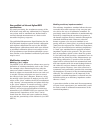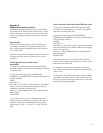
26
Appendix B
Dimensional considerations in coaxial
connectors
This appendix describes dimensional considera-
tions and required conventions used in determin-
ing the physical offset length of calibration
standards in sexed coaxial connector families.
Precise measurement of the physical offset length
is required to determine the OFFSET DELAY of a
given calibration standard. The physical offset
length of one and two port standards is as follows.
One port standard–Distance between “calibration
plane” and terminating impedance.
Two port standard–Distance between the Port 1
and Port 2 “calibration planes.”
The definition (location) of the “calibration plane”
in a calibration standard is dependent on the
geometry and sex of the connector type. The “cali-
bration plane” is defined as a plane which is per-
pendicular to the axis of the conductor coincident
with the outer conductor mating surface. This mat-
ing surface is located at the contact points of the
outer conductors of the test port and the calibra-
tion standard.
To illustrate this, consider the following connector
type interfaces:
7-mm coaxial connector interface
The “calibration plane” is located coincident to
both the inner and outer conductor mating sur-
faces as shown. Unique to this connector type is
the fact that the inner and outer conductor mating
surfaces are located coincident as well as having
hermaphroditic (sexless) connectors. In all other
coaxial connector families this is not the case.
3.5-mm coaxial connector interface
The location of the “calibration plane” in 3.5-mm
standards, both sexes, is located at the outer con-
ductor mating surface as shown.
Type-N coaxial connector interface
The location of the “calibration plane” in Type-N
standards is the outer conductor mating surfaces
as shown below.
Note
During measurement calibration using the Agilent
85054 Type-N Calibration Kit, standard labels for
the “opens” and “shorts” indicate both the stan-
dard type and the sex of the calibration test port.
The sex (M or F) indicates the sex of the test port,
NOT the sex of the standard. The calibration plane
in other coaxial types should be defined at one of
the conductor interfaces to provide an easily veri-
fied reference for physical length measurements.


















